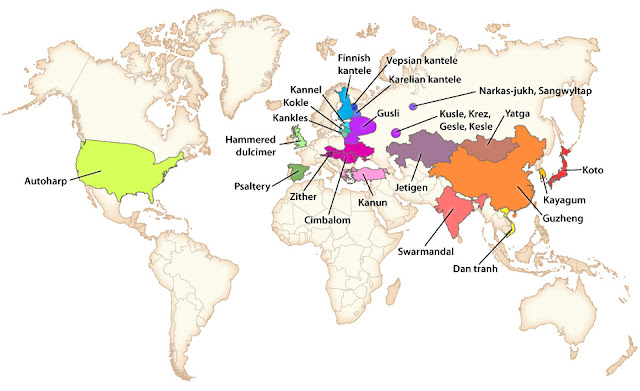No attempt at instrument modelling can ignore the development of instrument form and function over time. Instrument evolution opens a window not only onto our relationship to technology and environment, but also onto the erosion of community, as expressed through the decline in social music and dance.
Big, brave, open-source, non-profit, community-provisioned, cross-cultural and cucu crazy. → Like, share, back-link, pin, tweet and mail. Hashtags? For the crowdfunding: #VisualFutureOfMusic. For the future live platform: #WorldMusicInstrumentsAndTheory. Or simply register as a potential crowdfunder..
Instrument Evolution, Genealogy Or Family Trees
Note: the images in this post are drawn from external sites which you are encouraged to visit for further information.
Instrument evolution is a difficult topic, in that it has been subject to much the same chaotic drivers as humanity itself: accident or inspiration, materials availability, technical skills, usage, the vagaries of migration and the constraints of music-cultural traditions.
Instruments certainly developed alternative forms - in parallel, in various geographical locations and -despite common ancestry- often known under a variety of regional names.
The problem is to bring such information together in a form of concrete use to the worldwide music community.
Potential uses include discovery or identification, restriction of search, identifying regional differences such as in construction, materials, or playing styles, or the wider issue of comparative musicology.
Let's break the problem down. Here are our three main facets:
- instrument classification (Hornbostel-Sachs or other)
- geographical distributions
- naming, by region
- history
- concensus
Instrument Classification
A variety of data visualisation tools exist for each of these. For instrument classification, we have our established tree (dendrogram) view.
Geographical Distribution and Naming
Happily, representation of geographical location or distribution are well represented in data visualisation libraries, with the underlying data generally formatted (as for instrument classifications) in JSON formats, particularly the GeoJSON and TopoJSON specifications.
Our best mapping library bet is perhaps Leaflet.js, which is open source, supports zooming and panning, is free of the (proprietary) limitations of Google maps, and is both endorsed and used by a number of relatively young, high-tech firms.
History
Again, tree (dendrogram) structures and their underlying JSON format data are at our disposal, but there are alternatives:
It mustn't necessarily be a timeline, though. Here, for example (though not yet adapted to our problem), a timeline-linked radar plot:
Consensus
Clearly representation is not a problem. Libraries and examples exist: it is just a matter of applying them.
 |
| How to Document Living Heritage? |
The real problem is likely to lie more in the area of information gathering, community consensus and the suitable online, shared tools. Moreover, history itself is, unfortunately, also seen by some as a tool, especially in the context of identity..
Whatever: the core problem is to find a tool allowing systematic and moderated construction of the data stores mentioned above.
One possibility might be a modified version of jsoneditoronline or Jason Dorn's open-source json-editor. You can play around with a basic version (entirely adequate for these needs) here.
Incidentally, a further consideration is that multiple views may need to be generated from one data set. This, however, is likely to call into question some of the architectural decisions underpinning the platform - and especially that of avoiding URI (other than physical) routing.
Keywords
online music learning,
online music lessons
|
distance music learning,
distance music lessons
|
remote music lessons,
remote music learning
|
p2p music lessons,
p2p music learning
|
music visualisation
music visualization
|
musical instrument models
interactive music instrument models
|
music theory tools
musical theory
|
p2p music interworking
p2p musical interworking
|
comparative musicology
ethnomusicology
|
world music
international music |
folk music
traditional music
|
P2P musical interworking,
Peer-to-peer musical interworking
|
WebGL, Web3D,
WebVR, WebAR
|
Virtual Reality,
Augmented or Mixed Reality
|
Artificial Intelligence,
Machine Learning
|
Scalar Vector Graphics,
SVG
|
3D Cascading Style Sheets,
CSS3D
|
X3Dom,
XML3D
|








Comments, questions and (especially) critique welcome.